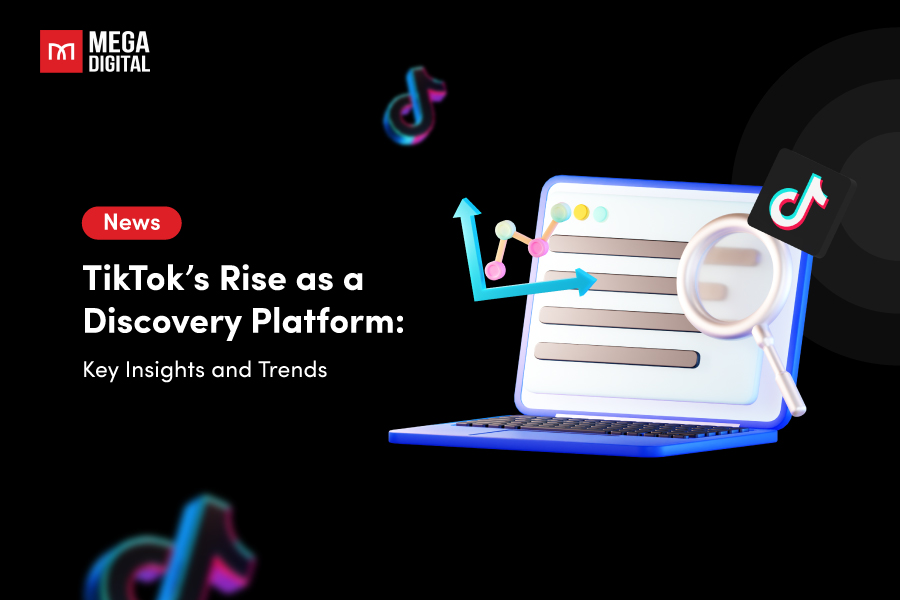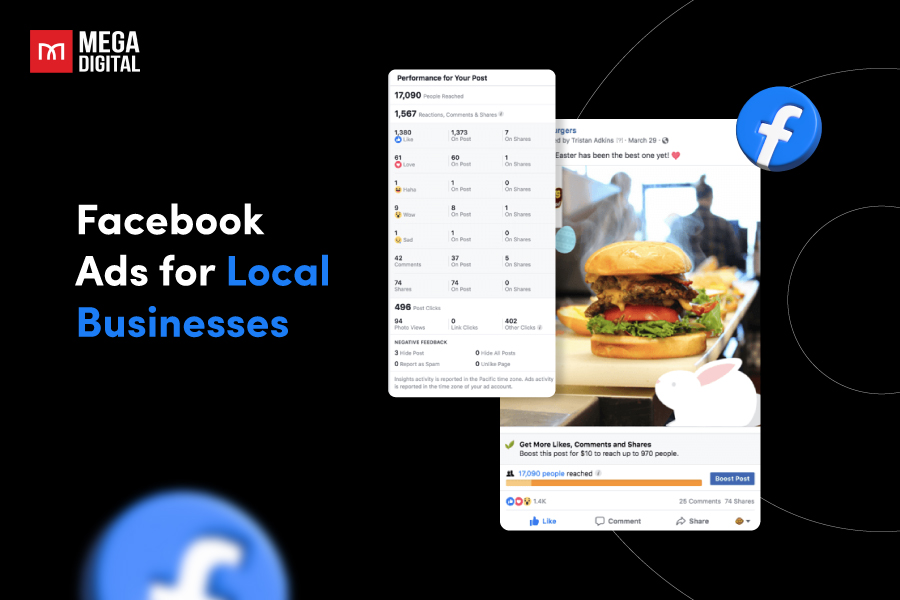With a potential advertising reach of 2.9 billion users, Facebook stands out as the most notable platform that connects businesses with their target audience. Leveraging its ad targeting system, businesses can ensure their ads reach the right people based on specific criteria such as demographics, interests, and behaviors. This article aims to guide you through the intricacies of Facebook ad targeting, helping you set up and optimize your ad campaigns for maximum success.
What is Facebook Ad Targeting?
Facebook ad targeting is a powerful feature that allows businesses to reach their ideal audience with precision. It works by leveraging the vast amount of data Facebook collects about its users, including demographics, interests, behaviors, and connections. This data precision allows advertisers to tailor their ads to specific user segments, increasing the likelihood of reaching individuals who are more likely to engage with the content or take desired actions.
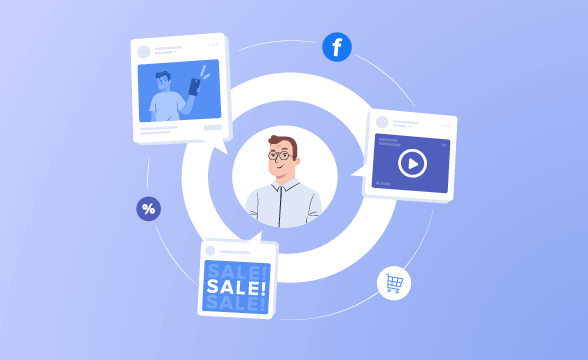
For example, if you’re a local bookstore, you can target ads to people who live in your area and have expressed an interest in reading. Or, if you’re an online clothing retailer, you can target ads to people who have recently visited your website or added items to their shopping cart.
All Facebook Ad Targeting Options
Facebook Ad offers a wide array of audience targeting options. This section will discuss each of these options in detail.
Detailed Targeting
Detailed Targeting is a feature available in the Audience section of ad set creation on platforms like Facebook. Detailed Targeting allows you to refine the audience for your ad campaign by specifying detailed criteria based on:
- Demographic
- Interest
- Behavior
Demographic Targeting
Demographic targeting is one of the most basic forms of targeting on Facebook. It allows you to target users based on information such as their age, gender, location, language, education, and relationship status. If your product or service is especially relevant to a specific demographic, these ad targeting options can be instrumental in tailoring your marketing efforts to reach the most receptive audience.
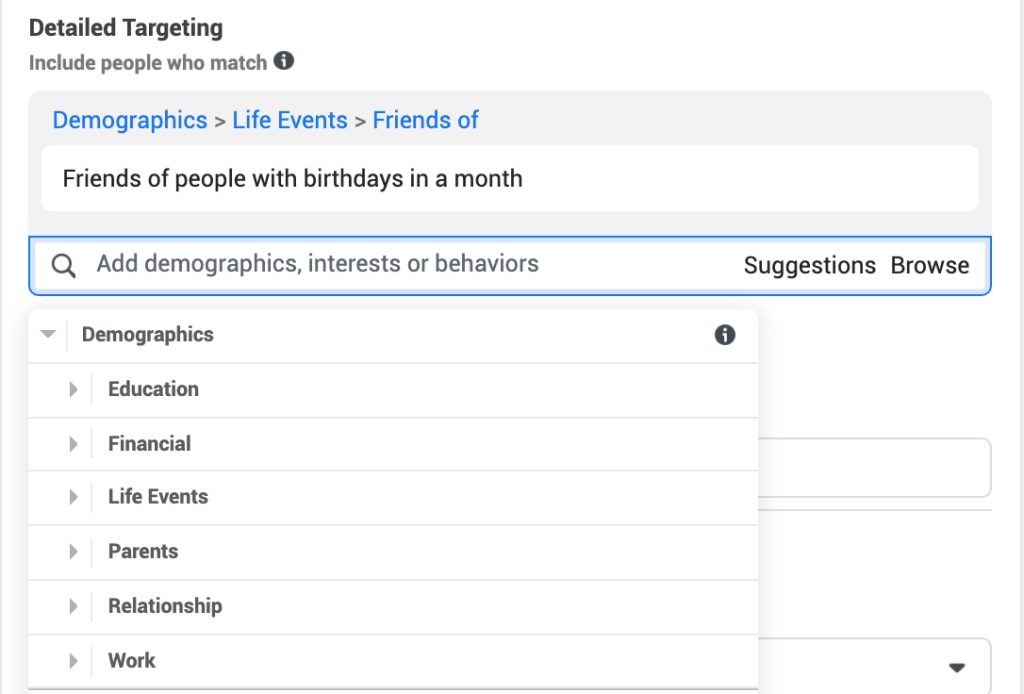
The demographic audience subcategories currently available include:
- Education (education level)
- Financial (income percentile)
- Life events (like birthdays and anniversaries)
- Parents (parental status)
- Relationship (relationship status)
- Work (employers, industries, or job titles)
Interest targeting
Interest targeting allows you to reach users based on their interests, hobbies, and pages they like on Facebook. This could range from broad categories like ‘Fitness and wellness’ to more specific interests like ‘Yoga’ or ‘Healthy eating’. For instance, a fitness center could target ads to users who have expressed an interest in fitness and wellness, or specifically in yoga.
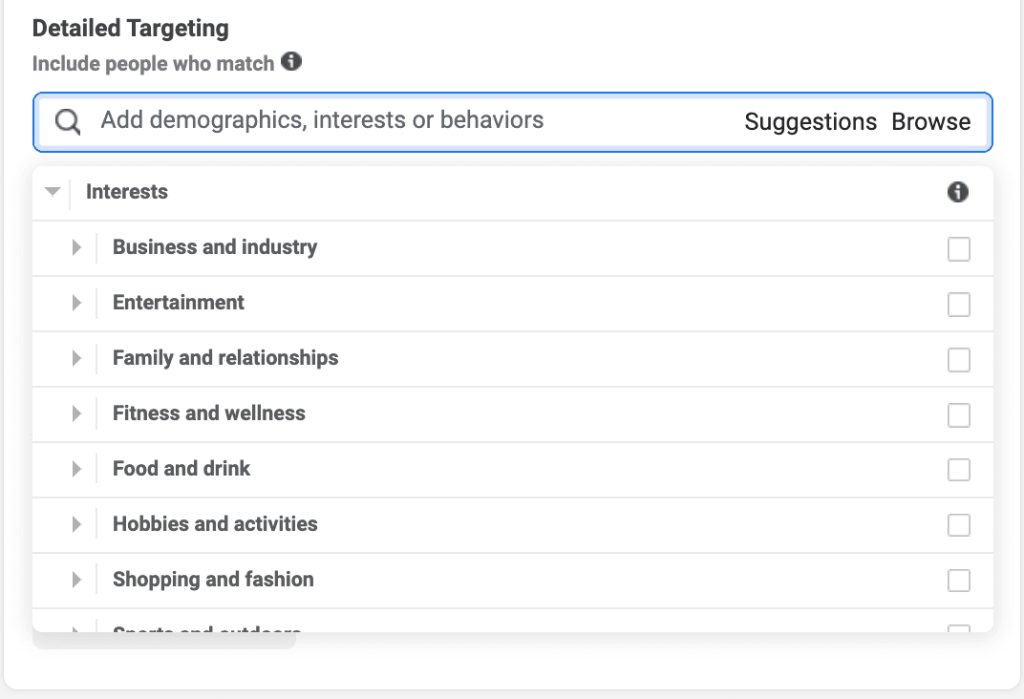
Here are some of the subcategories under interest targeting:
- Business and Industry
- Entertainment
- Family and Relationships
- Fitness and Wellness
- Food and Drink
- Hobbies and Activities
- Shopping and Fashion
- Sports and Outdoors
Behavior Targeting
Tracking user behaviors is crucial before delivering an ad of any form. It is often more impactful to direct ads towards individuals who have engaged with your blog posts or have become followers on your social media platforms. Behavior targeting lets you target users based on their behaviors, both on and off Facebook. This includes purchase behaviors, device usage, and other activities.
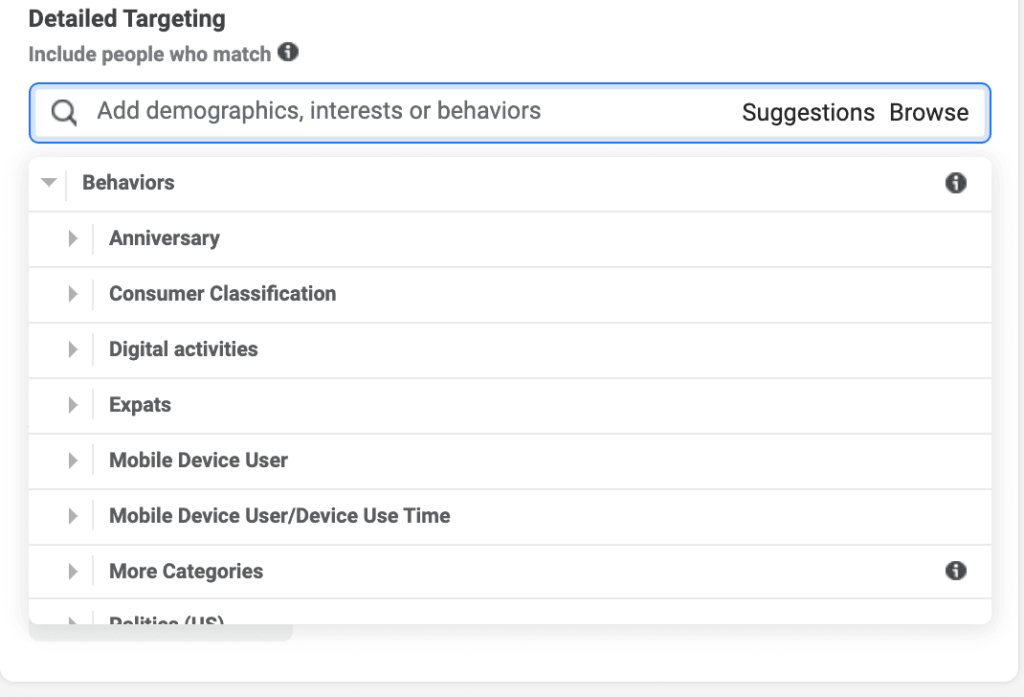
The behavior audience subcategories consist of:
- Automotive (DLX Auto Powered by Polk)
- Anniversary
- Charitable Donations
- Digital Activities
- Financial
- Mobile Device User
- Purchase Behavior
- Residential Profiles
- Travel
For example, an online electronics store could target ads to users who have recently purchased electronics or are frequent online shoppers.
Custom Audiences
If you already have a quality list of leads in your hands and aim to engage with them on Facebook, you can easily generate a Custom Audience to capture and convert those leads.
With a Custom Audience, you can utilize specific information you’ve collected about your leads. This could be customers who have purchased from you in the past, users who have visited your website, or users who have engaged with your content on Facebook. This proves to be an effective targeting option, especially if your objective is to upsell to existing customers. For example, an online clothing retailer could target ads to users recently visiting their website or adding items to their shopping cart.
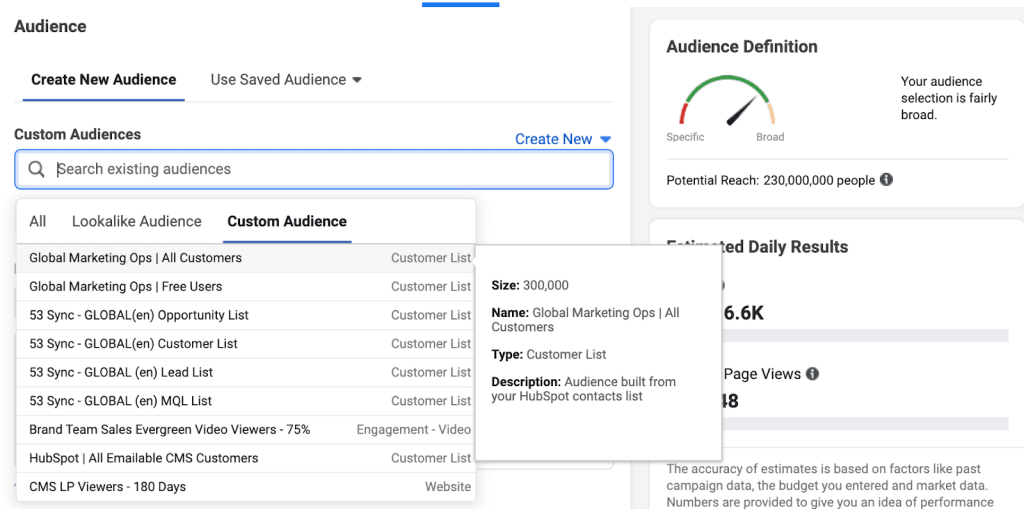
The way Facebook creates a Custom Audience based on your existing users’ traits is similar to that of the Lookalike Audience, which will be explained below.
Lookalike Audiences
As the name suggests, lookalike audiences enable you to reach new users with similar characteristics to your existing customers. Facebook creates these audiences by analyzing the characteristics of your custom audience and finding users with similar profiles. By establishing a Lookalike audience, you can aim for a significantly larger, yet still pertinent, group of potential Facebook users.

To fully comprehend what it means for an audience to “look” like your existing database, take a look at this example: Let’s say you upload your email subscriber list to Facebook as a custom audience. Facebook, firstly, identifies the following features of your users:
- In their mid-to-late twenties
- Live in Canada
- Work in the marketing field
- Show an interest in travel
Having all that data ready for use, Facebook could then find users who match all of these characteristics since users with those criteria seem most interested in what your brand has to offer.
Benefits of using Facebook Ad Targeting
Reaching the exact audience
With the variety of options to segment your audience based on demographics, interests, and behaviors, your ads are shown to the people who match your ideal customer profile and are most likely to be interested in your offerings. By reaching the exact audience, you can increase the chances of engagement, conversions, and, ultimately, sales.
Improved ad relevance
Ad relevance plays a crucial role in capturing customers’ attention and driving meaningful interactions. Tailoring ads to specific demographics ensures the content resonates with the audience, leading to higher click-through rates and better overall ad performance.
Cost efficiency
By narrowing down the target audience, you can avoid showing your ads to irrelevant or uninterested users. This ensures that your ad budget is spent effectively on reaching the most valuable audience who are more likely to convert. This efficiency results in better returns on investment.
Improved engagement
Targeting based on user behavior and interests increases the likelihood of users engaging with the ad. This engagement can include clicks, likes, shares, and comments, fostering a stronger connection between the brand and the audience.
A Step-by-step Guide to set up Facebook Ad Targeting for your campaigns
Setting up audience targeting for your Facebook ad campaigns involves a series of steps to define the characteristics of the audience you want to reach. Here’s a detailed guide:
Step 1: Access Facebook Ads Manager
Be sure you have a Facebook ad account ready for use, or else you can create a brand new account following one of these two methods:
- Through a Facebook personal account
- Through Business Ads Manager
>>> Read more: Simple walkthrough to create a Facebook ad account in 5 steps
Keep in mind that this personal kind of ad account has certain limitations that may cause you severe setbacks while running ad campaigns. Facebook does provide a better option, which is the Facebook Agency ad account. Facebook Agency ad accounts offer the ability to manage ads for multiple clients, providing advanced features, increased spending limits, and collaborative tools.
But as the name suggests itself, you can’t independently create an agency account unless you are a highly trusted Facebook Partner with a substantial advertising history on Facebook. Therefore, to acquire a Facebook agency account, advertisers need to reach out to Facebook Partners who offer this service like Mega Digital.
For the sake of future advertising conveniences, we recommend that advertisers should start using this account type to unlock unlimited features on Facebook.
Step 2: Create a new ad campaign
Click on the “+ Create” button to start a new ad campaign.

Choose the objective of your campaign.

Step 3: Define your audience on your ad set
Under the “Audience” section, click on “Create New” to define your target audience.
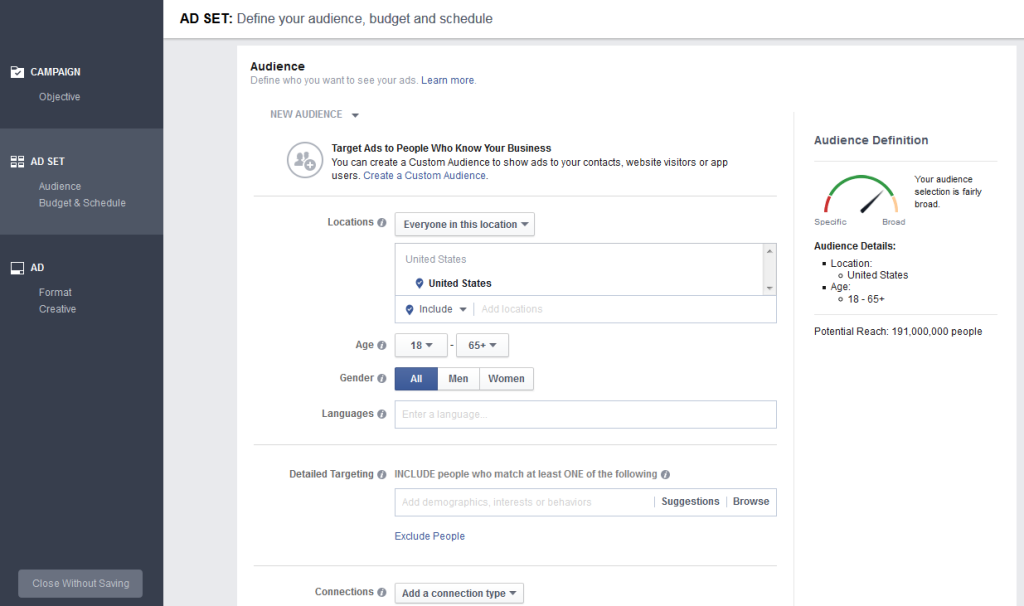
Step 4: Save your setting
Once you’ve defined your audience and finished your settings on every other sector as well, you can save it for future use.
Common Mistakes to Avoid when Using Facebook Ad Targeting
Executing Facebook ad targeting comes with its challenges. Understanding and addressing these issues is crucial for optimizing ad performance and maximizing returns on investment. Let’s look at some frequently encountered mistakes that advertisers make when using Facebook Ad targeting.
#1 Not understanding which audience to target
This most common pitfall can be attributed to several factors, often leading to inefficiencies and wasted resources. Advertisers may not conduct thorough audience research before setting up their campaigns. Their inaccurate perceptions of the target audience’s demographics, interests, and behaviors can result in poorly defined targeting criteria.
Solution: Rather than making groundless assumptions about your audience, analyze data about the audience’s demographics, interests, and search trends from Facebook’s audience insights to inform your targeting decisions.
#2 Targeting too narrowly
Advertisers might believe that a smaller, more specific audience will lead to higher engagement and conversion rates. However, this is not always the case. While precision is essential, overly narrow targeting may result in missing out on a broader audience that could be interested in your products or services.
Solution: While it’s important to target the exact audience, don’t target too narrowly, or you may miss out on so many other potential customers. Try targeting a wide range of people and then narrowing it down once you get more data.
#3 Rely on only one of Facebook’s targeting options
Facebook offers many different ways to target your audience. Each targeting option has its strengths and limitations. Using only one of them in your ad campaigns may result in missing out on audiences that could be effectively reached through other methods. Also, by sorting out your audience solely based on one targeting option, your audience will be way too big.
For example, only targeting a list of people whose birthdays are coming up will turn up a very broad audience. The people on it could have any number of interests or inclinations when it comes to their birthday festivities.
Solution: In this sense, we often find that using a combination strategy with interest targeting and demographic targeting suits our needs best.
#4 Not testing different audiences
Don’t jump right to the conclusion that one audience is better than another. If you have not done any testing with different audience segmentations, how can you be sure that one particular targeting setting will work wonders for your business? This fallacy is what many businesses have fallen into, and its consequences cost them a lot.
Solution: You should thoroughly carry out research on your audience and test different audience targeting options to find out which performs best. Try different combinations of interests, demographics, and other targeting criteria to figure out the best audience for your business.
Mega Digital’s Pro Tips to Optimize Facebook Ad targeting
To maximize the effectiveness of your Facebook ad campaigns, we’ll share some proven ad targeting tips that you should follow:
Understand and expand your audience with Audience Insights
The first step to successful ad targeting is understanding your audience. A tip here is that instead of figuring out your audience yourself, in a traditional way, you can utilize Audience Insights, an analytics tool that gives you lots of valuable information and insights about your audience’s preferences, online activities, and engagement patterns. This data becomes instrumental in refining your strategies to attract potential new followers and customers. Also, you can strategically target the existing users of your competitors, using the data gained from Audience Insights.
Utilize custom and lookalike audiences
Custom and lookalike audiences are powerful tools for reaching users who are likely to be interested in your business. Depending on the campaign objective and the nature of the customer data available, advertisers can:
- Custom audiences: ideal for targeting users who have already interacted with your business, helping businesses re-engage and nurture existing relationships.
- Lookalike audiences: suitable for reaching new users who are similar to your existing customers, expanding your reach to a larger audience that is more likely to convert.
Experiment with different ad targeting options
One of the keys to successful ad targeting is experimentation. Try creating different ad sets with varying targeting options to see what works best. For example, you could create one ad set targeting users based on demographics, another based on interests, and another based on behaviors. Monitor the performance of each ad set and adjust your strategy based on the results.
Separate your audience funnels for personalization
Each phase within the sales funnel represents levels of customer familiarity with your brand. For optimal organization, it is recommended that you create distinct campaigns according to:
- Prospecting audiences (utilizing detailed targeting and lookalikes).
- Middle-of-funnel audiences (focused on re-engagement).
- Bottom-of-funnel audiences (centered on retargeting).
This approach allows for clear delineation of each audience type, facilitating the prevention of any potential overlap between your audiences and funnels.
Allocate your budget more towards prospecting
It’s really tempting to funnel budget into your retargeting audiences at the very bottom of the funnel because those tend to give you the most high-value conversions. However, if you focus only on retargeting, you’ll run that audience dry, and ad fatigue, a situation when your audience is fed up with constantly seeing your ads, will be the death of your campaign.
Advertisers should allocate a significant portion of their budget to prospecting audiences rather than solely focusing on retargeting. Funneling the budget into the prospects is vital for sustained growth, audience diversification, and building brand awareness.
Conclusion
Mastering Facebook ad targeting can significantly enhance the success of your ad campaigns. By understanding and utilizing the various Facebook ad targeting options, implementing our Facebook ad targeting tips, and developing a robust Facebook ad targeting strategy, you can ensure your ads resonate with the right audience. If you need help from a trusted digital advertising agency with years of experience in leveraging targeted ad campaigns, contact Mega Digital today!







